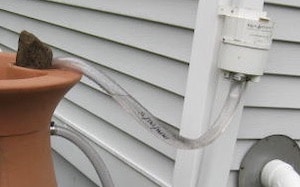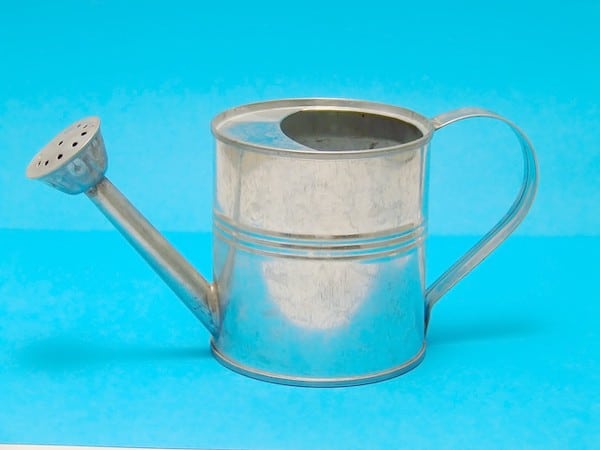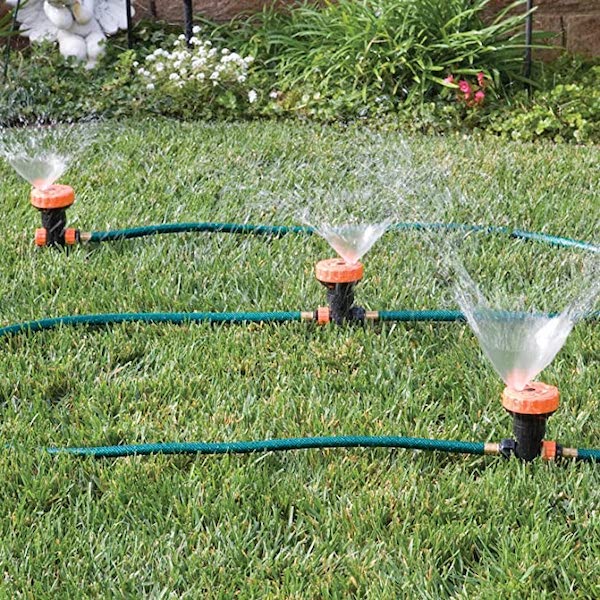Updated: May 1, 2020
Vegetable garden watering is probably the topic where Suburban Hobby Farmer gets the most questions. This article answers the most common vegetable garden watering questions.
Before we get into the questions, it’s important to note that the most common watering mistake made by backyard gardeners is to water too frequently and not long enough. This is bad for at least two reasons:
First, it encourages shallow roots and vegetable plants need to grow down deeper into the soil because this is where moisture is consistent and nutrients are available.

Harvest Water From Your Roof
All my articles on rain barrels and rain barrel downspout diverters.
Second, frequent watering keeps stems and leaves wet for too long, which encourages disease.
Before we get into the FAQ, let’s take a sec to get the legal words out of the way. This article may contain affiliate links. That means if you click and buy from my partners, I will make a tiny amount of money at no cost to you. This in no way affects my recommendations.
Watering FAQ
How much you need to water your vegetable garden depends on the (1) type of soil you have, (2) needs of the plants you’re growing, (3) air temperature and (4) air humidity. If you consider these four variables, your garden will tell you how much you need to water
Soil. If you have a sandy soil, the water runs right through it. So you’ll need to water more. Clay soil holds the water longer and requires less water.
Plant needs. Some plants like to sit in water. Some are easily damaged by too much water. You’ll need to know what your plants require in order to determine how much to water. Read the seed package if you are growing from seed or ask the garden center if you are buying seedlings. If you ask at the garden center, you will want to make sure that you ask one of their experts and not just any worker.
Temperature. When the weather is warmer, the soil dries out more quickly so water more often.
Humidity. Evaporation takes place more quickly in a dry desert than in a tropical rain forest. Water more in extreme dry and windy conditions.
When watering from the top, simulate the rain. Don’t use a high pressure blast, which damages topsoil and , of course, can damage the plants as well.
If you are watering at the soil level it is probably because you don’t want the leaves to get wet or you are trying to conserve water so it only get to the roots. With this method slow and steady drip irrigation is best. This give the water the chance to sink in. Otherwise, it will run off and cause erosion.
The best test is to stick your finger into the soil as deep as it will go. You can use a gloved hand if you don’t like getting your hands dirty. Be careful not to damage plant roots. You should try to get down over six inches because plant roots hang out between six and twelve inches deep.
If your finger comes up dry, you probably need to water. If not, you can wait.
Another indicator is wilting. Sometimes wilting means you need to water sooner. Keep in mind, however, that wilting can have many causes. There’s a good chance that wilting isn’t due to lack of water. It’s always best to use the finger test to be sure.
There are gadgets that will test soil moisture, but none of them are as good as the finger test.
How long you should water depends on how long it takes for water to penetrate below the six inch level. Often, when you look at your soil, it looks wet enough. But dig just a little and it’s still bone dry.
You can learn a lot by watering for 5 minutes and measuring how deep the moist soil goes. If it doesn’t go below six inches, water for 5 minutes more and test again. Repeat this test, each time adding two minutes until the moist soil reaches six inches. You’ll be surprised how long it takes to get down to six inches.
After you’ve done this test, you can use this amount of time as a rule of thumb when you’re watering.
You only need to water a vegetable garden every day when you first plant your seeds and are trying to germinate plants or when you first transplant your seedlings. After that it’s best to do the finger test to see how often you need to water. Of course, hot, dry, windy weather will require frequent watering.
Most of the time you should use drip irrigation for watering your vegetable garden. However, many experts disagree with me on this question.
First, let me define what I mean by the two different types of watering.
When I say watering from the top, I’m talking about using a hose with a sprayer, using a watering can or using a sprinkler.
On the other hand, drip irrigation is when you use a hose or pipes on the ground to drip water at a slow rate directly into the soil.
Many people don’t like drip because it’s hard to maintain and hard to distribute the water evenly and efficiently. Some people like it because you can place the hose or pipes under mulch.
This reduces evaporation and also the number of plant leaves that get wet. Keeping leaves dry helps prevent fungal problems. This is especially true when growing tomatoes.
Many people would rather water from the top because they can see and control where the water goes. Undoubtedly some water is absorbed through the leaves, so watering overhead has the advantage of getting more water to the plants more quickly.
You also can provide foliar feeding (fertilizer to the leaves) when you water from the top. This, obviously, is not possible through drip irrigation because the water never touches the leaves.
If you use drip irrigation, it’s best to water in the late afternoon or early evening because you don’t have to worry about getting the leaves wet and staying wet all night. Plus, the cooler night temperatures will allow the water to seep into the ground without evaporating.
If you water from the top, it’s best to water in the morning so the leaves will dry out. Watering late in the day increases the chances of fungal diseases because leaves remain moist all night long.
With this method, you also want to water before the heat of the day.
If you water from the top when it’s sunny and hot, there’s a good chance that the magnification of the sun through the drops could burn the leaves.
Watering during the heat also wastes water because of the high levels of evaporation.
You can reduce the water you need for your garden by using mulch to cover the soil. The deeper the mulch the slower soil will dry out.
Another strategy that garden book author Carol Deppe mentions is spacing plants more generously. The more space a plant has the less water you need. This philosophy is the exact opposite of square foot gardening.
A third way to conserve water is to use a rain barrel with your house water gutters. Click on this link for an article on rain barrel downspout diverter systems.
Water temperature does make a difference sometimes. At the beginning of the growing season you are often trying to warm the soil. Cold water can reduce the soil temperature significantly. Better to let the water warm in the sun before using it with your new seedlings.
All plants stop growing when the temperature surpasses a certain point. It’s different for each type of plant. Misting can lower the temperature when it’s too hot for growth.
When the water evaporates it lowers the surface temperature of the plants. It also can lower the soil temperature.
But I would advise against misting for this purpose. This is because water droplets will magnify the sun’s rays and result in plant scalding. It also can encourage plant diseases.
Instead, let the plants natural defenses against heat take over. This will encourage deep root growth, which is good for your plants.
Fabric raised beds, raised beds and pots require frequent watering. This is because they are above ground and drain well. This also is because they easily get warmer than the earth. Warm weather will make pots dry out faster. So you frequently will need to water pots everyday, but not always.
Related articles you might enjoy:
- Can You Plant Potatoes in Autumn?
- Fixing an Overflowing Rain Barrel
- My Rain Barrel Automatic Downspout Diverter
Suburban Hobby Farmer is a participant in the Amazon Services LLC Associates Program, an affiliate advertising program designed to provide a means for sites to earn advertising fees by advertising and linking to amazon.com.

